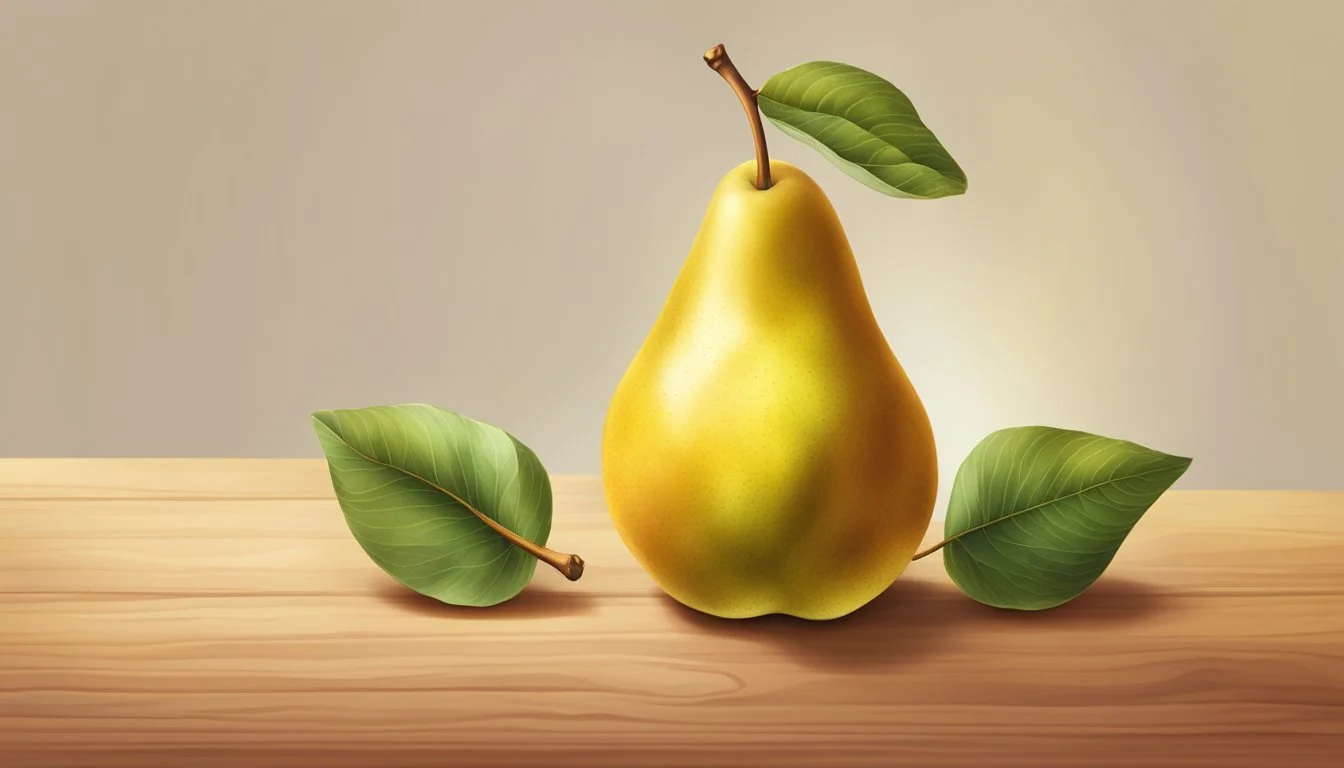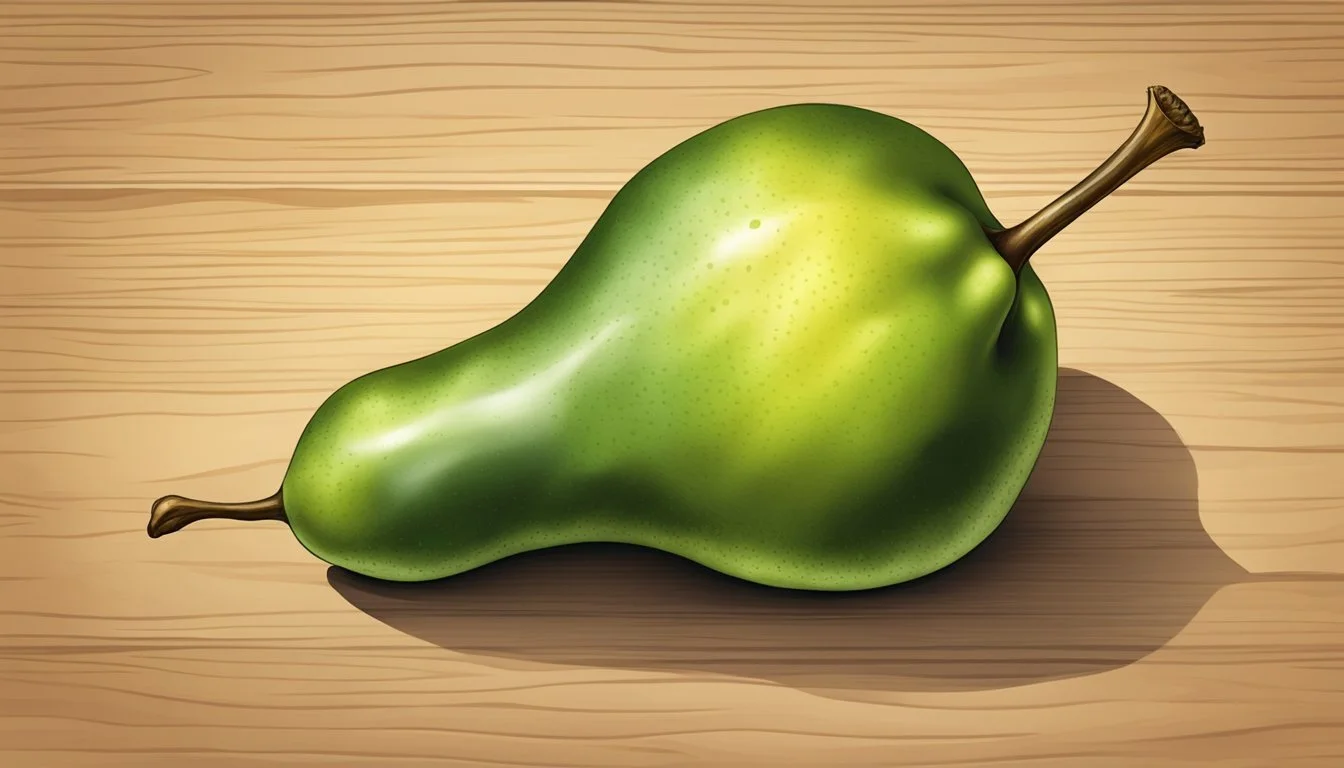How to Tell if a Concorde Pear is Ripe
Your Ultimate Guide to Perfect Pears
Determining the ripeness of a Concorde pear is crucial for both consumers and growers. Concorde pears, known for their elongated shape and sweet flavor, are a hybrid variety that combines the best qualities of Conference and Comice pears. Recognizable by their bright yellow-green hue when ripe, they offer a delicious taste and can be enjoyed in a variety of culinary contexts. Knowing the signs of ripeness ensures that the fruit is enjoyed at its best quality, with the right balance of sweetness and texture.
Key factors in identifying a ripe Concorde pear include its color, feel, and the slight give near the stem when gently pressed. These tactile clues are complemented by the pear's natural progression where it becomes more fragrant as it approaches peak ripeness. Since ripeness affects the culinary uses of the pear from fresh eating to cooking, understanding these indicators is essential. Proper harvesting and post-harvest handling further optimize the flavor and longevity of the fruit.
Key Takeaways
Color change to a yellow-green and a smooth, slightly waxy skin indicate ripeness.
A ripe Concorde pear will yield slightly to gentle pressure near the stem.
How the pear is handled after harvest affects its taste and storage life.
Identifying a Concorde Pear
When determining if a Concorde pear is ripe, its physical characteristics are the primary indicators. Concorde pears, a hybrid of the Conference and Comice pears, bear distinctive traits.
Appearance: The Concorde pear is known for its elongated shape, similar to the well-known Conference pear which originated in Europe. Its skin may exhibit some degree of russeting, not unlike the Bosc pear's textured appearance.
Color: The ripe fruit doesn't follow the typical color-changing pattern as seen in Bartlett pears. Instead, a ripe Concorde pear maintains its yellow-green hue, which can sometimes make judging its ripeness a more subtle task.
Ripeness Indicator: Color
Description: Bright yellow-green without significant change
Ripeness Indicator: Shape
Description: Elongated and akin to its Conference ancestor
Ripeness Indicator: Skin Texture
Description: Smooth, slightly waxy, with possible russet patches
Texture: Assessing ripeness involves a gentle touch. While the pear's skin should be smooth to the touch, slight softness around the neck is a reliable sign of ripeness. The rest of the pear should remain relatively firm.
In summary, one must look for a combination of the above characteristics with a focus on color consistency, the elongated shape, smoothing skin texture, and targeted softness to identify a ripe Concorde pear.
Understanding Ripeness
Identifying the perfect moment of ripeness in Concorde pears is crucial for experiencing their sweet and juicy flavor. This understanding enables consumers to enjoy the fruit at its peak.
Stages of Ripeness
Concorde pears, like many fruits, transition through several stages of ripeness. Initially, they are hard and contain high amounts of starch. As they ripen, the starch converts into sugars, and the pear softens. Unlike some fruits, Concorde pears do not exhibit dramatic color changes as they ripen; they transform from a green to a slightly more yellow-green hue. Observing this subtle shift is essential for determining when the fruit is approaching ripeness.
Ripening Process
The ripening of Concorde pears is influenced by the ethylene gas naturally produced by fruits. This gas accelerates the ripening process. At room temperature, pears ripen evenly and become sweeter and softer. To quicken ripening, one can store pears in a paper bag with other ethylene-producing fruits like apples or bananas. The concentrated ethylene gas in the enclosed space encourages the pears to ripen faster.
Signs of Ripeness
There are definitive ways to check for the ripeness of Concorde pears:
Check the Neck: Gently squeeze the neck, or stem end, of the pear. If it yields slightly to pressure, it indicates ripeness.
Firmness: The body of the pear should still be firm, but not hard. Overly soft body may imply overripeness.
Aroma: A ripe Concorde pear emits a fragrant aroma, which becomes more pronounced as it ripens.
Softness: The pear should have some give when pressed gently, indicating softness.
By understanding these signs, one can determine the precise moment when a Concorde pear is ripe and ready to be enjoyed for its optimal taste and texture.
Harvesting and Post-Harvest Handling
Proper harvesting and handling are crucial to ensure the Concorde pear retains its quality from tree to table. This section discusses the ideal time to harvest, methods to store pears while preserving freshness, and techniques to prolong ripeness.
Optimal Harvest Time
Harvesting Concorde pears takes place when they are mature but not yet ripe. This typically occurs in early fall. The pears should be picked when they are still firm to the touch and the skin color has a slight change—from deep green to a more yellow-green hue. Testing a sample pear for slight softness near the stem will often indicate maturity.
Storing and Preserving Freshness
Once harvested, maintaining the proper storage conditions is key to preserving the freshness of Concorde pears. They should be stored at 30 degrees Fahrenheit (-1 Celsius) and at 85 to 90% humidity. Under these conditions, pears can be kept fresh for an extended period. Any colder, and the pears risk damage; any warmer, and they will ripen too quickly. To conserve them, pears can be wrapped individually in paper and placed in a refrigerator.
Prolonging Ripeness
To control the ripening process after storage, Concorde pears can be kept at room temperature. Ethylene-producing fruits, such as bananas and apples, can be placed near the pears to accelerate ripening. On the contrary, removing these ethylene sources will slow down the ripening. Pears can also be placed in a paper bag to trap ethylene and encourage even ripening. Regular checks are necessary to ensure they do not overripen.
Culinary Uses and Recipes
The Concorde pear, known for its sweet vanilla flavor and firm texture, is highly versatile in culinary applications. It maintains its shape when cooked, making it ideal for both sweet and savory dishes.
Concord Pear in Cooking
Concorde pears can be utilized in a variety of ways in cooking due to their dense flesh that holds up well to heat. They are excellent for baking, poaching, and grilling, retaining their sweetness and adding a refined aroma to any dish.
Baking: Concorde pears stay firm and don't release excessive juice, preventing sogginess in pastries.
Poaching: They absorb flavors beautifully, making them ideal for desserts like poached pears in red wine.
Pairing and Combinations
The unique flavor profile of Concorde pears pairs well with various ingredients:
Cheese: A classic combination is Concorde pear slices with blue cheese, where the sweetness contrasts the tangy flavor.
Wine: Light white and sparkling wines complement the sweetness and aroma of the pear.
Recipe Ideas
Here are some specific recipe suggestions that highlight the Concorde pear:
Pear Tart: Thinly sliced Concorde pears layered on puff pastry with a sprinkle of sugar and baked until golden.
Savory Pear Salad: Mixed greens topped with diced Concorde pear, crumbled goat cheese, and a drizzle of balsamic dressing.
Concord Pear Varieties
In the realm of Concord pears, variations are found particularly in their taste profiles and physical characteristics. Navigating through the assortment of pear varieties, such as Concorde, Conference, Comice, Bartlett, and Bosc, facilitates a tailored selection to meet personal preferences for sweetness, texture, and use.
Characteristics of Different Varieties
Concorde Pear: This variety is a blend of the Conference pear, known for its elongated shape and russeted skin similar to the Bosc pear, and the Comice pear, cherished for its abundant juice and creamy texture. Consequently, Concorde pears feature a sweet flavor with aromatic qualities and a consistently smooth, not gritty, texture.
Colour: Bright yellow-green when ripe
Texture: Smooth, slightly waxy skin when ripe
Flavour: Intensely sweet with a distinctive fragrance of true pear
Conference Pear: Predominantly cultivated in Europe, the Conference pear sets itself apart with an oblong shape and a texture that, while firm, offers a buttery and slightly nutty flavor profile.
Comice Pear: This variety, known in the U.S. for its juiciness and creamy softness, is often favored for fresh eating due to its exceptionally sweet and rich taste.
Bartlett Pear: The Bartlett pear is a traditional choice, turning from green to yellow as it ripens, and is recognized for its signature pear flavor that is ideal for canning and cooking in addition to fresh consumption.
Bosc Pear: Bosc pears, with their distinctive russet skin, tend to be more firm and dense, suitable for baking or poaching due to their ability to retain shape and texture.
Choosing the Right Variety
When selecting a Concorde pear or its relatives, consumers should consider:
Purpose: Whether for fresh eating, baking, or canning, each variety brings unique qualities that enhance the overall culinary experience.
Sweetness and Texture: Sweetness levels and textures range from the honeyed softness of the Comice to the crisp firmness of the Bosc.
Ripeness Indicators: For Concorde pears in particular, ripeness is determined by a slight yield to gentle pressure near the stem rather than a change in color.
Growing Concorde Pears
Growing Concorde pears involves specific gardening techniques, propagation methods, and pest and disease management to ensure healthy trees and fruitful harvests.
Gardening Tips
A Concorde pear tree thrives in well-drained soil with a pH of 6.0 to 7.0, which is slightly acidic to neutral. Gardeners should follow these key steps:
Soil Preparation: Amend soil with compost, manure, or peat to improve drainage.
Sunlight: Plant where the tree will receive six to nine hours of sunlight daily.
Watering Needs: Water deeply, particularly during the first few years to establish the tree.
Pruning: Annual pruning promotes growth and increases fruit production.
Propagation and Grafting
For propagation, Concorde pears can be grafted onto a suitable rootstock which provides disease resistance and can control the size of the tree.
Rootstock: Choose a rootstock that ensures disease resistance and a compatible growth rate with the scion.
Grafting Season: Perform grafting in late winter or early spring for best results.
Techniques: Bud grafting or whip and tongue grafting are common methods used.
Managing Pests and Diseases
Effective management helps mitigate pests like aphids and diseases such as canker.
Regular Inspection: Check the trees frequently for signs of pests or disease.
Control Methods: Use horticultural oils, beneficial insects, or recommended fungicides when necessary.
Sanitation: Remove any diseased or dead material promptly and keep the orchard clean.
By adhering to these focused practices, gardeners can cultivate vibrant Concorde pear trees that yield high-quality fruit.
Health Benefits and Nutrition
Concorde pears offer an array of health benefits due to their nutritional content. These pears provide a good source of dietary fiber, which is essential for digestive health and can aid in the prevention of various conditions such as constipation. The fiber found in these pears can also have a beneficial effect on heart health by helping to lower cholesterol levels.
The fruit is also rich in essential vitamins, particularly Vitamin C, which plays a critical role in immune system function, skin health, and tissue repair. Additionally, Concorde pears contain Vitamin K, important for bone health and blood clotting processes.
Nutritional Profile of Concorde Pears (per 100g):
Nutrient: Calories
Amount: 57 kcal
Nutrient: Carbohydrates
Amount: 15.23 g
Nutrient: Fiber
Amount: 3.1 g
Nutrient: Sugars
Amount: 9.75 g
Nutrient: Protein
Amount: 0.36 g
Nutrient: Vitamin C
Amount: 4.3 mg
Nutrient: Vitamin K
Amount: 4.5 µg
Antioxidants present in Concorde pears, such as flavonoids and anthocyanins, may contribute to reducing inflammation and protecting against certain diseases, including cancer. The pear's low calorie yet nutrient-dense profile makes it an excellent choice for those who are maintaining a healthy diet, aiming for weight management, or seeking a natural energy boost.
Consuming these pears as part of a balanced diet ensures that one avails of these health-promoting nutrients. It is important to note that the specific benefits can vary among individuals, and pears should be consumed in moderation as part of an overall healthy lifestyle.
Purchasing and Selection Tips
When buying a Concorde pear, a shopper must pay attention to several key indicators to ensure the fruit is ripe and ready to enjoy. At the grocery or market, follow these guidelines:
Color: A ripe Concorde pear presents a bright yellow-green color. A predominantly green pear will require more time to ripen off the tree.
Feel: Gently press the neck of the pear; if it yields slightly to pressure, it's ripe. The skin itself should feel firm yet not hard.
Key Attributes to Check:
Attribute: Color
Description: Bright yellow-green indicates ripeness
Attribute: Skin Firmness
Description: Should yield slightly to gentle pressure at the neck
Attribute: Surface
Description: Watch for uniformity, avoiding pears with cuts or bruises
Ripe Concorde pears are known for their sweetness and aromatic qualities. When selecting a pear in-store, it's important not to handle them roughly as they bruise easily. Check the pear's surroundings; even if it's not bruised itself, pears piled together can often cause damage that isn't immediately visible.
Remember, a ripe fruit will be slightly soft at the stem end and will have a fragrant pear scent when brought close to the nose. If the pears at the market are not quite ripe, one can purchase them and allow them to ripen at room temperature at home.
Shoppers seeking Concorde pears should find them available from fall to early winter, the peak harvest time for this variety. However, due to efficient storage techniques, it's often possible to find them year-round. When selecting this pear, anticipate enjoying a fruit with a creamy texture, and enrich your culinary experience with its unique flavor profile.
Frequently Asked Questions
What are the indicators of ripeness in Concorde pears?
Color: Mature Concorde pears have a bright yellow-green hue.
Feel: They should yield slightly to pressure near the stem.
Neck Test: Gently press the neck of the pear; softness indicates ripeness.
How can one check the ripeness of a Concorde pear?
Examine the color for a yellow-green appearance.
Press the neck gently; if it yields, the pear is ripe.
Test the body; it should be firm with minimal give.
Does color change significantly as Concorde pears ripen?
No, Concorde pears maintain their color as they ripen, making the neck test for softness more reliable.
Can you ripen Concorde pears at home?
Yes, one can place them at room temperature to promote ripening.
How should ripe Concorde pears be stored?
Ripe pears must be refrigerated to slow down the ripening process and extend their shelf-life.
Is it possible to eat Concorde pears before they are fully ripe?
While possible, they are best enjoyed when fully ripe for optimal flavor and texture.
Do all pears ripen in the same way as Concorde pears?
No, different varieties have distinct signs of ripeness. For example, Bartlett pears change color, unlike Concorde pears.






